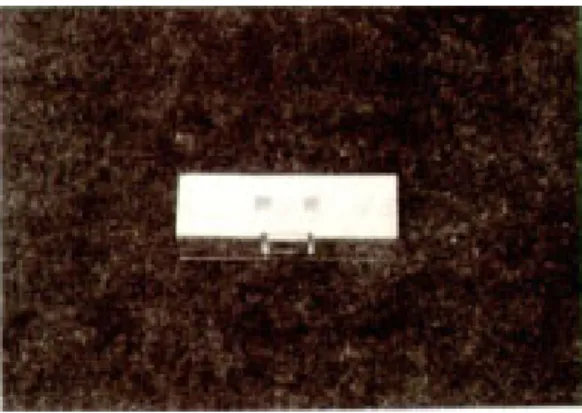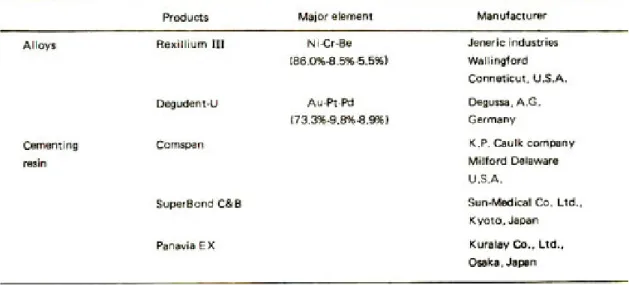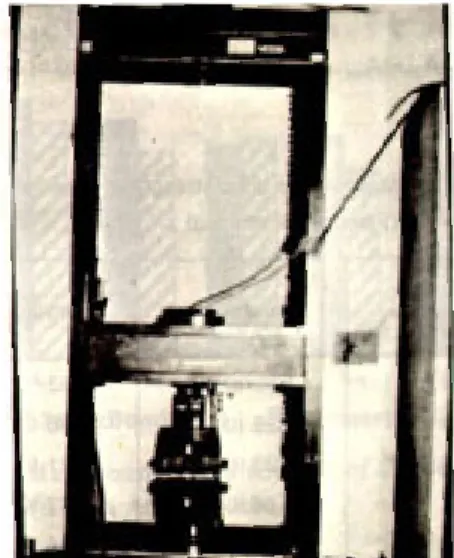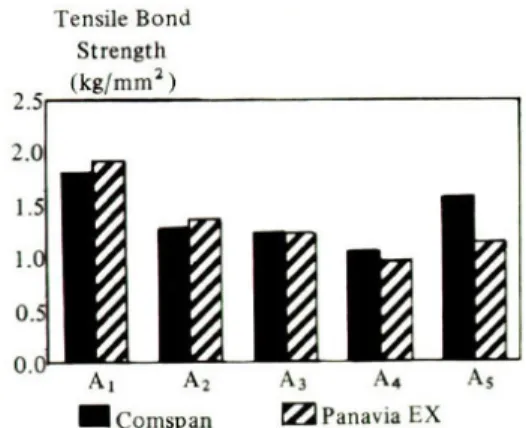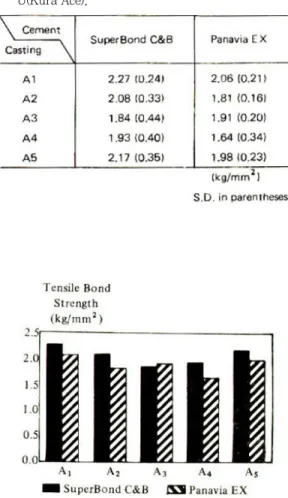< 목 차 >
Ⅰ. 서 론
Ⅱ. 실험재료 및 방법
Ⅲ. 실험성적
Ⅳ. 총괄 및 고안
Ⅴ. 결 론 참고문헌 영문초록 사진설명 사진부도
I. 서 론
결손치아 회복을 위해 인접 자연치를 삭제하는 통상 적인 술식은 술자나 환자 모두에게 상당한 고통을 수 반하는 비가역적인 방법이다. 더구나 치주적으로 문제 가 있는 치아의 경우 특히 하악 전치등은 치질 삭제의 어려움은 물론 치수의 보존 관점에서도 여러가지 문제 를 야기하게된다. 이에 보다 많은 치질을 보존할 수 있 고 장기적인 치아 건강에도 유익함은 물론 시술 과정 중 환자가 보다 편안할 수 있는 방법을 찾게 되었다(10,
15).
법랑질의 외형을 수정하는 정도의 치질 삭제로 결손 치를 회복하는 수복물의 발달은 치과보철학 역사의 전 기를 이룩하였다.
1995년 Buoncore(6)가 85% 인산으로 법랑질 표면 을 부식시켜 레진과 법랑질의 결합을 시도한 이후 치 질에 대한 레진의 결합력을 증가시키려는 연구가 시도 되어 왔다.(2, 4, 5, 7, 11, 12, 13).
1973년 Ibsen,(8)Portnoy(9)등은 acrylic 인공치아 나 발거된 치아를 결손치아 대신 인접치에 부착시켰 고, Rochette(3)는 치주고정을 위해 천공시킨 금합금 splints를 하악전치에 레진으로 부착시켰다. 레진과 접착되는 천공금속면의 거대유지구조는 레진의 마모 와함께 치아에서 탈락하는 단점을 보여 금속면의 미세 유지구조를 얻는 방법에 대한 연구가 시작되었다(16, 17,
37).
그후 80년대에 들어오면서 Thompson(18, 21, 22) 등은 전기화학적식각법으로 레진과 식각된 금속사이 의 결합력을 증진시킬 수 있음을 이용해 결손치를 수 복하는 Maryland Bridge를 소개하게 되었다.
그 이후 전기화학적식각법의 결합력에 관한 연구(23,
25, 26, 30, 31, 32, 33, 42, 46)와 임상적연구(19, 27, 28, 29)가 행해져 왔고 보다 법착성이 우수한 접착시멘트의 개발이 이루 어지게 되었다(34, 35, 36, 38, 39, 40, 48).
- 대한 치과 보철학회지 Vol. 28 No. 2, 1990 -
반복주조된 치과용 합금의 피착면 처리방법에 따른 접착성 수지와의
접착강도에 관한 실험적 연구
서울대학교 치과대학 치과보철학교실
정금태∙ 양재호∙ 이선형∙ 정헌영
동시에 전기화학적식각법의 여러가지 불편함과단 점을 극복하기 위한 새로운 유지구조를 얻는 새로운 유지 구조를 얻는 방법들이 발표되었다.
LaBarre등(43)은 retention bead를 이용한 유지방 법을 고안했고 Hudgins등(44, 45)은 납형조각시 sieved salt를 이용해 미세유지구조를 얻었으며 Love등(49)은 immersion etching법을, Livaditis(50)는 chemical etching system을, Stokes등(51, 52)은 porous metal powder coating법을 발표했다.
Musil등(53)은 silicoating에 의한 레진과 금속간의 결합력을 소개했고 1986년 Tanaka등(56)은 비귀금속 합금 표면을 산화용액으로 처리해 접착 시멘트의 결합 에 필요한 산화막을 형성시켰고, anodic oxidation을 일으켜 산화막을 형성시키는 EZ-OXISOR도 개발하 게 되었다(57).
이러한 처리 방법들은 대부분 비귀금속 합금에 사용 되는 방법들이었고 금합금을 수지접착 수복물에 이용 할 수 있는 방법도 발표되었다.
Tanaka등 이 발 표 한 표 면 열 처 리 법(58, 61), Yamashita등이 발표한 Sn전석법(59, 73), 이온방전을 이용한 이온도금법(60, 61)등은 금합금에 사용되는 방법 들이었다.
주조하고 남은 잔량의 금속을 재사용하는 것은 경제 적인 관점에서 통상적으로 행해지고 있는데 이에 대한 연구는 주로 도재와 금소간의 결합력에 관한 것이 대 부분 이었다. Neloson등(63)은 니켈-크롬합금의 재주 조에 대한 연구에서 50%의 새 금속을 섞은 반복주조 는 물리적 성질, 미세구조, 임상적 특징에 어떤 변화도 초래하지 않았다고 했으며, Rasmussen등(63)은 85%
이상의 재주조 금속의 사용은interfacial void의 크기 와 발생 빈도를 증가시킨다고 보고했다.
Thompson등(72)은 재주조 금속을 사용하면 전기화 학적 식각후 레진과의 결합력이 감소한다고 보고하고 있다.
이에 저자는 4차례 반복 주조된 금속 시편을 제작하 여 Oxy-Etch식각기에 의한 전기화학적 식각법, 산화 알루미늄 분사법, EZ-OXISOR에 의한 양극산화법, Kura Ace에 의한 Sn전석법등 4가지 방법으로 금속 피착면을 처리한 후 BIS-GMA복합레진 시멘트인
Comspan, 인산에스텔계 복합레진 시멘트인 Panavia EX, 4-META 함유 레진 시멘트인 SuperBond C&B로 접착해 인스트론으로 접착인장강 도를 측정하고 표면변화를 관찰하기 위해 주사전자현 미경을 이용해 다소의 지견을 얻었기에 이에 보고하는 바이다.
II. 실험 재료 및 방법
1. 실험 재료
금속 시편 제작을 위해 비귀금속 합금은 Rexillium III, 귀금속 합금은 Degudent-U를 사용하였고 접착 시멘트로는 Comspan, Panavia EX, Superbond C&B를 사용하였다(Table 1)
2. 실험 방법
1) 금속 시편의 제작
금속 시편의 규격 통일을 위해 가로 4m, 세로 4m, 높이 10m의 금속봉을 제작한 후 Silicone으로 복제한 Mold를 제작했다(Fig. 1).
이 Mold내로 인레이왁스(Shofu Co.,japan)를 주 입해 납형을 제작하였다. Rexillium III의 경우 고온 인산염 결합 매몰제인 Hi-Temp 2(Whip Max Corp., Louisville, Kenturchy, U.S.A.)
Fig. 1. Silcone mold for wax pattern.
Degudent-U는 Biovest(Dentsply Co., U.S.A)에 매몰한 후 120문간 실온에서 경화시키고 제조회사의 지시대로 소환하여 Rexillium III의 경우 고주파 주조 기(Yoshida, Co., Japan)로, Degudent-U는 원심 주조하였다.
주조체의 금속 피착면을 평평하게 유지하게 유지하 기위해 산화알루미늄으로 분사 처리후 #200, #400,
#800,#1200Sic연마지로 연마하였다.
주조금속, 피착면 처리방법, 접착 시멘트의 종류에 따라 8개군으로 나누고(Table. 2) 각군 마다 새 금속 으로 주조한 시편을 A1, A1주조 후 남은 잔향으로 주
조한 시편을 A2, A2 주조후 잔량으로 주조한 시편을 A3, A3주조후 잔량으로 주조한 시편을 A4, A4주조후 잔량에 동향의 새 금속을 섞어 주조한 시편을 A5로 분 류했고, A1, A2, A3, A4, A5각각 5쌍씩 25쌍의 금속 시편을 각 군마다 제작했다(Fig. 2).
2) 금속 시편의 산화 처리
모든 금속 시편을 도재 소성 주기를 거친 것과 동일 한 조건을 만족시켜 주기 위해 1800�F 까지 4번 가열 한 후 산화알루미늄 분사로 금속 산화물을 제거한 후 수세했다.
Tabel 1. Material, Composition and Manufacturer
Table 2. Alloy, treatment method and cementing resin.
3) 금속피착면 처리
① 전기화학적 식각처리군.
Oxy-Etch 식각기(Oxy dental products, Inc., Hillside, New Jersey, U.S.A.)를 사용해 10% 황산 액에서 300mA/㎠의 전류로 3분간 식각처리한 후 18%염산액에 10분간 초음파세척해 증류수에 수세하 여 건조시켰다(Fig. 3).
② 산화알루미늄 분사처리군
금 속 시 편 을 50의 산 화 알 루 미 늄 (Biobond aluminum oxide : Dentsply International Inc., U.S.A.)으로 3.1kg/㎠의 압력으로 분사구 입구에서 시편까지 5mm의 간격을 두고 5초간 분사하였다. 이
후 3분간 증류수에서 초음파세척한 후 건조시켰다.
③ 양극산화처리군
EZ-OXISOR(Towagiken Co., Kyoto, Japan)표 면처리액((NH4)2 S2O8)을 피착면에 충분히 바르고 0.3mA의 전류를 30초간 보매 표면처리후 초음차 세 척하였다(Fig. 4).
④ Sn전석처리군
Kura Ace(Kuralay Co., Ltd., Osaka, Japan)장 치의 제어부, 전석대, Pincett전극을 접속시킨후, 금 속 시편을 수세용기에 넣어 1분간 세척한다. Pincett 전극을 사용해 피전석물을 잡고 전석액중에 깊이 담그 고 15초간 전석을 실시했다(Fig. 5).
4) 금속 시편의 접착
전기화학적 식각처리군은 Comspan과Panavia EX로 접착했고, 산화알루미늄 분사처리군, EZ- Fig. 2. Preparation of specimen.
Fig. 3. OXY ETCH. Fig. 4. EZ-OXISOR.
OXISOR에 의한 양극산화처리군, Kura Ace에 의한 Sn 전석처리군은 SuperBond C&B와 Panavia EX 로 접착했다.
금속 시편 접착시 20의 시멘트 두께를 유지하기 위 해 micrometer(Mitutoyo Co., Tyoko, Japan)를 이 용해 접착시킬 2개의 시편 길이를 측정한 후 micrometer gauge를 20만큼 증가시킨 길이에서 시 멘트로 접착시킨 시편을 micrometer사이에 위치시켜 시멘트가 경화될 때까지 방치했다(Fig. 6).
5) 접착 금속 시편의 보관
접착된 금속 시편을 실온의 증류수에서 24시간 보 존 시켰다.
6) 접착 인장 강도의 측정
시편을 인장강도측정기(Instron Model 1125)에 고 정한 후 chart speed 20mm/min, crosshead speed 0.5mm/min로 인장 강도를 측정 했다(Fig. 7).
7) 주사 전자 현미경 관찰
표면 처리된 금속의 미세 구조를 관찰하기위해 주사 전자현미경(JSM-T2000)으로, 400배,2000배로 관 찰했다(Fig. 8).
8) Bond Failure 관찰
인장강도 측정 후 결합 실패의 양상을 알아보기 위 해 macrolens(Nikon, Japan)을 이용해 2배 확대 관 찰했다.
Fig. 6. Micrometer and specimen alignment. Fig. 8. Scanning electron microscope.
Fig. 7. Unversal testing machine(Instron).
Fig. 5. Kura Ace.
III. 실험 성적
1) 인장 강도
가 군별 평균 인장강도와 표준 편차는 Table 3, 4, 6과 같다. 피착면 처리 방법과 접착 시멘트의 동류에 따른 8군간의 차이와 각군 내 A1, A2, A3, A4, A5의 차 이를 알아 보기위해 일원분산분석과 Duncan’s multiple range test를 실시했다(Table 7, Fig. 13).
전기화학적 식각군인 1군의 A1의 접착인장강도는 1.81kg/㎟ 로 A2, A3, A4는 현저하게 감소된 접착강도 를 보여 주고 있고 A5는 1.58kg/㎟로 A1과 유의성 있 는 차이는 없었다.2군의 경우 A1의 접착강도는 1.92kg/㎟인데 A2, A3, A4, A5의 접착강도와는 차이 를 보였다. 1군과 2군의A1접착강도의 비교를 위해 t- test를 실시한 결과 유의 있는 차이는 없었다(p > 0.05)
(Table 3,Fig. 9).
산화알루미늄 분사군인 3군과 4군의 경우A1, A2, A3, A4, A5사이의 접착인장강도 차이는 인정할 수 없 었으며 A1접착강도를 비교해 보면 SuperBond C&B 를 사용한 3군의 경우 Panavia EX를 사용한 4군보다 접착인장강도가 켰으나 통계적 유의성은 없었다(p >
0.05)(Table 4, Fig. 10).
EZ-OXISOR에의한 양극산화처리군인 5군과 6군 의 경우 A1, A2, A3, A4, A5의 접착인장강도의 차이는 없었으며 A1접착 강도를 비교 해 보면 Panavia EX 를 사용한 6군이 SuperBond C&B를 사용한 5군데에 비해 약간 큰 접착강도를 나타냈으나 통계적 유의성은
Table 3. Mean tensile bond strength of Rexillium III(Electrolytic etching)
Table 4. Mean tensile bond strength of Rexillium III(Aluminum oxide blasting)
Fig. 10. Mean tensile bond strength of Rexillium III(Aluminum oxide blasting)
Fig. 9. Mean tensile bond strength of Rexillium III(Electrolytic etching)
없었다(p > 0.05)(Table 5. Fig.11).
Kura Ace로 전석처리한 7군과 8군의 경우 A1, A2, A3, A4, A5의 접착강도의 차이는 없었고 경우 A1접착 강도 비교 에서는 SuperBond C&B를 사용한 7군의 접착강도가 Panavia EX를 사용한 8군에 비해 컸으나 통계적 유의성은 없었다(p > 0.05)(Table 6. Fig. 12).
2) 주사전자현미경 관찰
주사전자현미경 관찰 소견을 보면 전기화학적 식각 군의 경우 A1시편에 비해 A2, A3, A4, A5시편은 lamellar interdendric arm의 제거가 현저히 부족하 게 나타났으나 interdendric gamma prime phase
Table 5. Mean tensile bond strength of Rexillium III(EZ-OXISOR)
Fig. 11. Mean tensile bond strength of Rexillium III(EZ-OXISOR)
Table 6. Mean tensile bond strength of Degudent- U(Kura Ace).
Fig. 13. Mean tensile bond strength of A1specimmen.
Fig. 12. Mean tensile bond strength of Degudent- U(Kura Ace).
의 제거는 큰 차이가 없었다. 산화알루미늄 분사군과 EZ-OXISOR에의한 양극산화처리군의 경우 A1, A2, A3, A4, A5의 차이가 없었으며 Sn 전석군의 경우 A1이 A2, A3, A4, A5에 비해 보다 균일한 요철 구조를 나타 내고 있었다(Fig. 14-Fig. 33).
3) Bond Failure관찰
전기화학적 식각군의 경우 모두 adhesive failure 를 나타냈으나 나머지군에서는 adhesive failure와 cohesive failure가 같이 나타났고, 산화알루미늄 분 사군중 SuperBond C&B로 접착한 3군의 A1과 Sn전 석군 중 SuperBond C&B로 접합한 7군의 A1의 경우 는 모두 cohesive failure를 나타냈다(Fig.34- Fig.37).
Ⅳ. 총괄 및 고안
전기화학적 식각법은 획기적인 수지 접착 수복물의 유지 구조를 얻는 방법이었으나 여러단계의 처리과정 을 거치는 동안 오차가 생길 수 있고 식각의 균일성을 확보하기 어려운 단점과 함께 임상적으로도 mental-
composite계면에서 결합 실패가 일어나고 있음을 볼 수 있다. 이에 따라 보다 간편하게 확실한 유지를 얻을 수 있는 방법에 대한 연구가 진행되었고, 접착성이 있 는 새로운 레진 시멘트의 개발이 이루어졌다. BIS- GMI계통인 Comspan의 경우 금속 표면과는 기계적 결합에 의지하는 반면에 adhesion-promoting monomer인 4-META(4-methacryloxy- ethyltrimellitate anhydride)가 함유된 SuperBond C&B 나 인산 에스텔계 monomer구성 원자단의 인산 기(P-OH, P=O)와 금속피착면 처리에의해 형성된 표 면의 산화막과의 수소 결합과 van der Wall’s force 에 의한 결합도 가능한 Panavia EX는 금속과의 기계 적 결합이외의 화학적 결합도 가능하게 되었다. 이런 장점 때문에 대부분 수지접착 수복물의 경우 BIS- GMI계통의composite레진을 이 접착성 레진이 대체 하고 있다.
접착성 레진의 경우 금속 표면에 적절한 산화막이 존재해야 우수한 결합력을 발휘하므로 금속 표면에 산 화막을 형성 시켜 주는 여러가지 방법들이 소개되고 있다. Yamashita등은 oxidation을 위한EZ- OXISOR를 고안했고 Tanaka등은 산화 용액을 이용 했다.
Thompson등의 보고에 의하면 재주조된 금속을 사 Table 7. ANOVA and Duncan’s grouping of each group
용하면 1.59㎏/㎟의 접착강도를 나타냈는데 본 실험 에서는 1군의 경우 A2 1.28㎏/㎟, A3 1.23㎏/㎟, A4
1.06㎏/㎟, A51.58㎏/㎟의 접착강도를 보였으며 A5의 접착강도는 A1의 접착강도에 비해 통계학적 차이는 없 는 것으로 나타났으나 A1에 비해 모두 감소된 접착강 도를 보여주고 있고, 2군의 경우 A2 1.36㎏/㎟, A3
1.21㎏/㎟, A40.97㎏/㎟, A51.14㎏/㎟의 접착강도를 보이고 있는데 A1의 1.92㎏/㎟에 비해서 현저히 감소 된 접착강도를 나타냈다. 이것은 재주조 금속을 사용 하면 접착강도가 감소된다는 Thompson의 보고와 일 치하고 있다. 주사전자 현미경 관찰에서도 반복주조시 편의 경우 intradendtitic gamma prime phase의 제거에 의한 유지구조에는 큰 차이가 없으나 intradendtitic arm의 제거는 훨씬 적은것으로 보아 접착강도의 감소와 일치되는 양상을 보였다.
피착면을 산화알루미늄으로 분사하는 것은 금속표 면의 roughening과 함께 금속표면의 debris를 기계 적으로 제거함으로써 접착제의 wettability를 증진시 키는 효과가 있다. 아울러 피착면에 형성된 요철구조 로 인해 피착면적을 증가시키고 금속 표면에서 방사되 는 전자가 여러 화학반응에 관여하여 결합력을 증가시 키게 되는데, 산화알루미늄의 입자크기도 접착강도에 영향을 미쳐서 50μm인 것이 가장 큰 접착강도를 나타 낸다는 보고35)에 따라 50μm의 산화알미늄을 사용했 고 분사기의 압력도 일정하게 유지하기 위해 3.1㎏/㎟
의 압력으로 고정해 분사를 실시했다. 분사기의 tube 와 피착면사이의 거리는 5mm로 하고 5초간 분사했는 데 이것 역시 이 방법에 의한 유지구조의 관찰시 가장 분명한 요철구조가 얻어진다는 연구결과에 따른 것이 었다.
산화알루미늄 분사군인 3군의 경우 A12.33㎏/㎟, A31.99㎏/㎟, A52.06㎏/㎟, A21.80㎏/㎟, A41.69
㎏/㎟보다 비교적 큰 접착강도를 보였는데 Dincan’s muntiple range test 결과 A1, A5, A3사이에는 유의 성 있는 차이는 없었고 A2, A3, A4, A5사이에도 차이 가 없는 것으로 나타나 A1과 나머지 A2, A3, A4, A5사 이에 점진적인 차이가 있었으나 분명한 접착강도의 감 소가 있다고 볼 수는 없었다.
산화알루미늄 분사군인 4군의 경우 A1, A2, A3, A4,
A5접착강도 사이에는 통계적 유의성 있는 차이는 없 었다. 결국 산화 알루미늄 분사군의 경우 반복사용된 금속으로 주조된 시편의 경우 접착강도의 차이가 없는 것으로 나타났는데 산화 알루미늄 분사효과는 금속의 강도와 밀접한 관계를 가진 것으로 사료되 반복 주조 에 의해 금속자체의 물리적 성질의 변화가 생기지 않 는다는 Hesby(62)의 연구 결과와 일치되어 반복주조군 의 접착강도의 변화가 없는 것으로 사료된다. 주사전 자현미경 소견상 재주조군일지라도 첫주조군과 차이 를 발견할 수 없었는데 이 사실도 접착강도의 차이가 존재하지 않음을 간접적으로 암시해 준다. Watanabe 등(73)은 RexilliumIII로 제작된 시편을 산화 알루미늄 분사처리후 SuperBond C&B와 Panavia EX접착시 킨 후 인장강도를 측정한 결과 2.45㎏/㎟, 2.02㎏/㎟
로 SuperBond C&B의 결합력이 크다고 보고 하고 있 으나 본 실험의 3군과 4군의 A1접착강도를 비교해보 면 SuperBond C&B를 사용한 3군이 Panavia EX를 사용한 4군에 비해 크게 나타났으나 통계적 유의성은 없는 것으로 나타났다.
산화알루미늄 분사군이 접착인장강도가 전기화학 적 식각군보다 크게 나타났는데 전기화학적 식각법의 경우 복잡한 장비와 처리과정을 거치는 것을 생각해 보면 산화 알루미늄 분사법이 보다 효율적인 접착강도 를 얻는 방법임을 보여주고 있고, 산화 알루미늄 분사 군의 경우 BIS-GMA계통의 composite 레진 세멘트 인 comspan을 사용해 실험하지 않은 것은 comspan 의 겅우 접착강도가 적게 나올 것을 예상했기 때문이 다.
EZ-OXISOR에 의한 양극산화군인 5군과 6군의 A1, A2, A3, A4, A5의 접착인장강도 사이에는 차이가 없었으며 5군과 6군이 A1접착인장강도를 비교해 보면 SuperBond C&B 와 Panavia EX 접착강도 사이에 는 유의있는 차이는 없었다. 접착을 위해서는 금속표 면에 산화막을 형성시켜주는 처리가 필수적(56, 58)인데 비귀금합금의 겅우 Yamashita(57) 는 양극산화법을 이용했고 Tanaka등(48)은 질산용액에 담금으로써 산 화막을 형성시켰으나 내수성문제로 인한 임상적 실패 의 경우가 보고 되어 있어 새로운 potassium permanganate 가 첨가된 황산용액에서 산화막을 형
성시킨 결과 접착강도가 상승되었으나 도리어 과도한 산화막이 형성되면 접착강도가 감소된다고 하며, EZ- OXISOR에 의한 양극산화법의 경우 결합력의 편차가 너무 커서 만족할만한 결합이 이루어지지 않음을 보고 하고 있는데 본 실험에서는 통계적유의성은 없었으나 EZ-OXISOR에 의한 양극산화군보다 산화알루미늄 분사군의 접착강도가 크게 나타났다. 이것은 EZ- OXISOR의 산화막 형성 능력의 신빙성에 의심을 가 게하고 산화알루미늄분사법이 효과적인 접착을 얻을 수 있는 방법임을 보여 주고 있는 것이다.
금 합금을 수지접착수복물에 이용하는 방법으로는 porous metal power coating법(51, 52), silicoating(54) 법, 고온 가열법(58, 61), Sn전석법(60)등이 있다. Stokes 의 보고에 의하면 porous metal power coating법을 전기화학적 식각법에 견줄만한 결합력을 갖고 있다고 했고, silicoating 법은 전기 화학적 식각법에 비해 2 배이상의 결합력을 보고하고 있다. Tanaka(61)등은 고 온 가열법에 의해 금 합금의 표면처리후 4-META 함 유 레진인 Orthomite SuperBond로 접착시켜 결합 력을 측정한 결과 2.05㎏/㎟ 의 결합력을 보고하고 있 고 Watanabe등은 Ttpe IV금합금을 Kura Ace에 의 한 전석처리결과 SuperBond C&B와의 접착강도는 2.60㎏/㎟, Panavia EX의 경우 1.88㎏/㎟를 보고하 고 있는데 본 실험에서는 SuperBond C&B가 2.27㎏
/㎟. Panavia EX 2.06㎏/㎟으로 Watanabe의 실험 결과와는 달리 두 접착 시멘트사이의 접착강도 차이는 인정할 수 없었다. 반복 주조된 A2, A3, A4, A5의 경우 접착강도의 차이를 보이지 않았는데 주사전자현미경 소견상으로는 A1의 소견이 A2, A3, A4, A5에 비해서 보다 명확한 요철구조를 보이고 있었다.
Bond failure양상은 비교적 접착강도가 크게 나타 난 3군의 A1과 7군의 A1에서 cohesive failure가 나타 났고 1군과 2군에서는 모두 adhesive failure를 나타 냈으며 나머지 군에서는 adhesive failure와 cohesive failure가 같이 나타났다. Watanabe등의 보고에 의하면 대부분 cohesive failure가 나타난다 고 했으나 본 실험의 양상이 다르게 나타난 것은 전반 적인 접착강도가 낮은 것에 기인한 것이 아닌가 생각 된다. 전기화학적 식각법이외의 방법에서는 반복 주조
시 접착강도의 차이가 없었다고 하여도 반복 주조 금 속을 사용해 시편을 만드는 과정에서 defect가 많이 생겨 시편을 새고 제작한 경우가 많았고 defect부위를 없애기 위해 연마과정도 많이 시행되었음을 감안한다 면 주조후 남은 잔량만으로의 주조는 신중히 고려되어 야하며 수지 접착수복물의 경우 주조체의 적합도가 중 요한 요소이므로 주조성과 표면의 미세구조에 대한 보 다 깊이 있는 연구가 진행되어야 할 것으로 사료된다.
Ⅴ. 결 론
4차례 반복주조된 RexilliumIII 금속 시편을 전기 화학적식각법, 산화 알루미늄 분사법, EZ-OXISOR 에 의한 양극산화법으로 표면처리하고 4차례 반복주 조된 Degudent-U 금속 시편을 Kura Ace에 의한 Sn전석처리후 접착레진시멘트인 Comspan, SuperBond C&B, Panavia EX로 접착하여 접착인 장강도의 측정과 주사전자현미경 관착을 통해 다음과 같은 결론을 얻었다.
1. 전기화학적 식각군은 반복주조함에 따라 접착 인 장 강 도 가 감 소 되 었 으 며 Comspan과 Panavia EX 의 접착인장강도는 차이가 없었다 (p>0.05).
2. 산화알루미늄 분사군, EZ-OXISOR에 의한 양 극산화군, Kura Ace에 의한 Sn전석군은 반복 주조함에 따라 접착인장강도의 차이는 없었고 SuperBond C&B 와 Panavia EX 의 접착인장 강도에도 차이가 없었다(p>0.05).
3. 주사전자현미경 관찰시 전기화학적 식각군과 Kura Ace에 의한 Sn전석군은 반복주조함에 따 라 차이가 있었으나 산하알루미늄분사군, EZ- OXISOR에 의한 양극산화군은 반복주조 하였 음에도 차이가 없었다.
4. Bond failure 관찰시 전기화학적 식각군은 adhesive failure를,산화알루미늄 분사군, EZ-OXISOR에 의한 양극산화군, Kura Ace에 의 한 Sn전 석 군 은 adhesive failured와 cohesive failure가 같이 나타났다.
Reference
1. Ibsen, R.L., Nevillem K. : Adhesive restorative dentistry, Philadelphia, W.B.Sounders Company, P.158, 1974.
2. Miura, F., Kazuhiko, N., Masuhara, E. : New direct bonding system for plastic brackets. Am.J.
Orthod., 59 : 350,1971.
3. Rochette, A.L. : Attachment of a splint to enamel of lower anterior teeth. J. Prosthet. Dent., 30 : 418,1973.
4. Buonocore, M. G. : Principles of adhesive retention and adhesive restorative materials.
J.A.D.A., 67 : 382, 1963.
5. Buonocore, M.G. : New anterior restorative materials. Int. Dent. J., 18 : 406, 1968.
6. Buonocore, M. G. : A simple method of increasing the adhesion of arcyclic filling materials to enamel surfaces. J. Dent, Res., 34 : 849, 1955.
7. Buonocore, M.G. : Adhesive sealing of pits and fissures for carries prevention, with use of ultraviolet light. J.A.D.A., 80 : 32, 1970.
8. Ibsen, R.L.. Fixed prosthodontics with natural crown pontic using as adhesive composite.
J.S.Calif. Dent. Assn., 41 : 100, 1973.
9. Portnoy, L.L. Constructing a composite pontic in a single visit. Dent. Surv., 49 : 20, 1973.
10. Stolpa, J.B. : An adhesive technique for small anterior fixed partial dentures. J. Prosthet. Dent.
34 : 513, 1975.
11. Brown, R.L. : Adhesive bonding of various methods to hard tooth tissue, Ⅳ. : Bonding to dentine, enamel and fluorapatite improved by use of surface active comonomer. J. Dent., 3, 538, 1976.
12. Short, G.M., Hembree, Jr. J.H. and Mcknight, J.P. : The bond strength of resin system to
etched enamel. J. Prosthet. Dent., 3,538, 1976.
13. Reisbick, M.H., Brodsky, J.F. : Strength parameters of composite resin. J. Prosthet.
Dent., 26 : 178, 1971.
14. Moon, P.C. : Resin-bonded bridge tensile bond strength utilizing porous pattern. J. Dent. Res., 63(special issue) : 320, 1984(Abstr. No. 1345).
15. Howe, D.F., Denehy, G.E. : Anterior fixed partial dentrues utilizing the acid0etch technique and a cast metal frame work. J. Prosthet. Dent., 37 : 28, 1997.
16. Dunn, B., Reisbick, M.H. : Adherence of ceramic coating on chromium-cobalt structrues. J. Dent.
Res., 95 : 328, 1976.
17. Tanaka, T., Atsuta, M., Uchiyama, Y., Nakabayshi, N., Masuhara, E. Spherical powder for retaining thermosetting acrylic resin veneers.
J. Prosthet. Dent., 39 : 295, 1978.
18. Thompson, B.P., Del Castillo, E., Livaditis G.J.
Resin bond to electrolytically etched nonprecious alloys for resin bonded prosthesis J. Dent. Res., 60(Special issues A. : 327(Abstr. No. 265), 1981.
19. Thompson, V.P., Wood, M. : Etched casting bonded retainers recalls : Results at 3-5years. J.
Dent. Res., 65 : 748,1986(Abstr. No.265).
20. Sveeney, E.J., Moore, D.L., Pooner, J.J. : Retentive strength of acid-etched anterior fixed partial denture : An in virto comparison of attachment technique. J.A.D.A., 100 : 198, 1980.
21. Thompson, V.P., Del Castillo, E., Livaditis, G.J. : Resin-bonded retainers. Part 1 : Resin bond to electrolytically etched nonprecious alloys. J.
Prosthet. Dent., 50 : 771, 1983.
22. Livaditis, G. J., Thompson, V.P. : Etched castings. An improved mechanism for resin- bonded retainers. J. Prosthet. Dent., 47 : 52, 1982.
23. Hill, G.L., Zidan, O., Gomez-Marin, O. : Bond
stregths of etched metals : Effect of errors in surface area estimation. J. Prosthet. Dent., 56 : 41, 1986.
24. William, V.D., Drennon, D.G., Silverstone, L.M. : The effect of retainer design on the retention of filled resin acid-etched fixed partial dentures. J.
Prosthet. Dent., 48 : 417, 1982.
25. Thompson, V.P. Grolman, K.M., Liao, R. : Bonding of adhesive resins to various nonprecious alloys. J. Dent. Res., 64(Special issue) : 314, 1985.(Abstr. No. 1258).
26. Creugers, N.H.J., van’t Hof, M.A., Vrijhoef, M.M.A. : A clinical comparion of three types of resin-retained cast metal prostheses. J.
Prosthet. Dent., 56 : 297, 1986.
27. Eshleaman, J.R. Moon, P.C., Barnes, R.F. : Clinical evaluation of cas metal resin-bonded anterior fixed partial denture. J. Prosthet. Dent., 51 : 761, 1984.
28. Williams, V.D., Denehy, G.E., Thayer, K.E., et al.
: Acid-eteched retained cast metal prostheses. : A seven year retrospecitve study. J.A.D.A., 108 : 629,1984.
29. 양재호 : Maryland bridge의 적용분포와 결합실패에 관한 임상적연구(Ⅰ). 대한치과 보철학회지, 24 : 7, 1986.
30. 박헌석, 이선형, 양재호, 장완식 : 식각된 비귀금속합금 과 법랑질을 복합레진계 세멘트로 접착시킨 경우의 접 착 인장강도에 관한 연구. 대한 치과보철학회지, 24 : 85, 1985.
31. 박상원, 양홍서 : 식각된 비귀금속합금과 법랑질간의 접 착인장 강도에 관한 연구, 대한치과보철학회지, 24 : 303, 1987.
32. 조인호 : 상이한 설계법 및 접착제를 사용한 접착성 주 조보철물의 접착강도에 관한 비교연구, 치과임상, 77 : 67, 1988.
33. Bardy, T., Doukoudakis, A. Rasmussen, S.T. : Experimental comparison between preforated and etched-metal resin-bonded retainers. J.
Prosthet. Dent., 54 : 361, 1985.
34. Omura, I., Yamauchi, J., Hamada, I., Wasa, T. : Adhesive and mechanical propertise of a new dental adhesives. J. Dent. Res., 63 : 233, 1984(Abstr. No. 561)
35. Masuhara, E. : New 4-META. Adhesive resin.
Dent Outlook, 59 : 661, 1982.
36. Yamashita, A. : The clinical application of new adhesive resin(MMA-4-META-TBBB-B. t o adhesion bridge(adhesion splint). Dent. Outlook, 59 : 691, 1982.
37. Tanaka, T., Atsuta, M., Uchiyama, Y., Kawashima, I. : Pitting corrosion for retaining acrylic resin facings. J. Prosthet. Dent. 42 : 282, 1979.
38. Yamashita, A., Yamami, T. : Procedures for applying adhesive resin(MMA-TBB. t o crown and bridge restoraitons. Part1 : The influence of dental nonprecious alloy and the treatment of inner surface of metal to adhesion.
J. Jpn. Pros. Soc., 26 : 584, 1982
39. Yamashita, A., Kondo, Y., Fujita, M. : Adhesive strength of adhesive resin. Panavia EX to dental alloys, Part 2 : Adhesive strength of precious alloys. J. Jpn. Pros. Soc., 26 : 1023, 1984.
40. Masak, N. : Clinical application of 4-META, adhesive resin. Prac. Prosthodont., 15 : 53, 1982.
41. Pegoraro, L.F., Barrack, G. : A comparison of bond strength of adhesive cast restoration using different designss, bonding agents and luting resins. J. Prosthet. Dent., 57 : 133, 1987.
42. Barrack, G. : Recent advances in etched cast restoraions. J. Prosthet, Dent., 52 : 619, 1984.
43. La Barre, E.E., Ward, H.E.. : An alternative resin-bonded retoration. J. Prosthet. Dent., 52 : 247,1984.
44. Hudgins, J.L., Moon, P.C., Knap, F.G : Particle- roughened resin-bonded retainers. J. Prosthet.
Dent., 53 : 471, 1985.
45. Moon, P.C., Knap, F.J.Acid-etched bridge bond stregth utilizing a new retention method. J.
Dent. Res., 62(special issue)(Abstr. No. 296),1983.
46. Meier, J.G., Jensen, M.E., Mayclin, T. : Effect of surface treatment on the bond strength of etched metal resin-bonded retainers. J. Prosthet. Dent., 57 : 133, 1987.
47. Hamada, T., Shigeto, N. Yanagihara, T. : A decade of progress ofr the adhesive fixed partial denture. J. Prosthet. Dent., 54 : 24, 1985.
48. Tananka, T., Takeyma, M., Atsuta, M., Nakabayashi, N., Masuhara, E. : 4-META opaque resin-A new strongly adhesive to nickel- chromium alloy. J. Dent. Res., 60 : 1967, 1981.
49. Love, L.D., Breitman, J.B. : Resin retention by immersion-etched alloy. J. Prosthet. Dent., 53 : 623, 1986.
50. Livaditis, G.J. : A chemical etching system for creating micromechanical retention tn resin- bonded retainers. J. Prosthet. Dent., 56 : 181, 1986.
51. Stokes, A.N., Tidmarsh, B.G. : Porous metal coating-a microretensive alternative to etched metal prostheses. Quintessence International, 18 : 675, 1987.
52. Stokes, A.N., Tidmarsh, B.G. : Porous metal coating for resin bonding system. J. Prosthet.
Dent., 56 : 170, 1986.
53. Musil, R., Riller, H.J. : The adhesion of dental resins to metal surface- The Kulzer Silcoater Technique. Kulzer & Co. GmbH, 1985.
54. Twesme, D.A., Lacefield, W. R., O’neal, S.J. : Effect of silocoating and etching on alloy composite bonding. J. Dent. Res., 65 : 320, 1988.
55. Laufer, B.Z., Nicholls, J.I., and Townsend, J.D. : SiOx-C coating : A composite to metal bonding mechanism. J. Prosthet. Dent., 60 : 320, 1988.
56. Tanaka, T., : Fujiyama, E., Shimizu, H., Atsuta, M. : Surface treatment of non-precious alloys for
adhesion fixed partial dentures. J. Prosthet.
Dent., 55 : 456, 1986.
57. Yamashita, A., Yamami, S., Ishii, M., Yamaguchi, T., Uramoto, T. : Procedure for applying adhesive resin(MMA-TBB) to crown and bridge restoraiton. J. Jpn. Pros. Soc., 26 : 1118, 1982.
58. Tanaka, T., Nagata, K., Takeyana, M., Nakabayashi, N., Masuhara, E. : Heat treatment of gold alloy to get adhesions with resins. J. Jpn.
Soc. Dent. Appar. Mater., 21 : 96, 1980.
59. 山丁敦 : 치과접착성 Resin의 기초와 임상(하권), Quintessence 출판주식회사, Tokyo, 1983.
60. Tanaka. T., Hirano, M., Kawahara, M., Matsumura, H., Atsuta, M. : A new ioncoating surface treatment of alloy for dental adhesive resin. J. Dent. Res., 67 : 1376, 1988.
61. Tanaka. T., Atsuta, M., Nakabashi, N., Masuhara. E. : Surface treatment of gold alloy for adhesion. J. Prosthet. Dent., 67 : 271, 1988.
62. Hesby, D.A., Kobes, P., Garver, D.G., Pelleu, G.B. : Physical properties of repeatedly used nonprecious metal alloy. J. Prosthet. Dent., 44 : 291, 1980.
63. Nelson, D.R., Palik, J.F., Morris, H.F., Comella, M.C. : Recasting a nickel-chromium alloy. J.
Prosthet. Dent., 55 : 122, 1986.
64. McLean, J. W. : The science and art of dental ceramics, vol. 1, Chicago : Quintessen Publishing Co., 1979.
65. Rasmussen, S.T., Doukoudakis, A.A. : The effect of using recast metal on the bond between porcelain and a gold-palladium alloy. J.
Prosthet. Dent., 55 : 447, 1980.
66. Harcourt, H.J. : The remelting of cobalt- chromium alloys. Br. Dent. J 112 : 198, 1962.
67. Aquilino, S.A., Diaz-Arnold, A.M., Krueger, G.E.
: Tensile bond strengths of electrolytically and chemically etched base metal. Internation. J.
Prosthodono., 3 : 93, 1990.
68. Barzilay, I., Myers, M.L., Cooper, L.B., Graser, G.N. : Mechanical and chemical retention of laboratory cured composite to metal surface. J.
Prosthet. Dent., 59 : 13, 1990.
69. Creuger, N.H., Wells, P.R., Vrijhoef, M.M. : Four bonding systems for resin-retained cast metal prostheses. Dent. Mater., 4 : 85, 1988.
70. Re, G.J., Kaiser, D.A., Malone, W.F.P., Garcia- Godoy, F. : Shear bond strengths and scanning electron microscope evaluation of three different retentive methods for resin bonded retainers. J.
Prosthet. Dent., 59 : 568, 1988.
71. Matsumura, H., Nakabayshi, N. : Adhesive 4- META/MMA-TBB opoaque resin with poly(methyl methacrylate)-coated titanium dioxide. J. Dent. Res., 67 : 29, 1988.
72. Del Castillo, E., Thompson, V.P. : Electrolytically etched nonprecious alloys : Resin bond and Laboratory Variables. J. Dent. Res., 61(Special issue.: 186, 1982.
73. Watanabe, F., Powers, J.M. : In vitro bonding of prosthodontic adhesive to dental alloys. J. Dent.
Res., 67 : 479,1988.
74. Stevens, A., Bradshaw, B., Christensen, R., Bamgerter, V., Christensen, G. : Comparison of three surface treatments and eleven cements for resin retained porsthesis. J. Dent. Res.(Special issue)6 : 199, 1987(Abstract No. 742)
75. Takeyama, M., Kashibuchi, S., Nakabayashi, N., Masuhara, E. : Studies on dental self-curing resin. Adhesion of PMMA with bovine enamel or dental alloys. J. Jpn. Soc. Dent. Apparatus Mater. 19 : 179, 1978.
EXPLANATION OF FIGURES
Fig. 14. SEM photomicrograph showing A1speciman of Rexillium III treated by electrolytic etching (×400) (×2000)
Fig. 15. SEM photomicrograph showing A2speciman of Rexillium III treated by electrolytic etching (×400) (×2000)
Fig. 16. SEM photomicrograph showing A3speciman of Rexillium III treated by electrolytic etching (×400) (×2000)
Fig. 17. SEM photomicrograph showing A4speciman of Rexillium III treated by electrolytic etching (×400) (×2000)
Fig. 18. SEM photomicrograph showing A5speciman of Rexillium III treated by electrolytic etching (×400) (×2000)
Fig. 19. SEM photomicrograph showing A1speciman of Rexillium III treated by aluminum oxide blasting
(×400) (×2000)
Fig. 20. SEM photomicrograph showing A2speciman of Rexillium III treated by aluminum oxide blasting
(×400) (×2000)
Fig. 21. SEM photomicrograph showing A3speciman of Rexillium III treated by aluminum oxide blasting
(×400) (×2000)
Fig. 22. SEM photomicrograph showing A4speciman of Rexillium III treated by aluminum oxide blasting
(×400) (×2000)
Fig. 23. SEM photomicrograph showing A5speciman of Rexillium III treated by aluminum oxide blasting
(×400) (×2000)
Fig. 24. SEM photomicrograph showing A1speciman of Rexillium III treated EZ-OXISOR (×400) (×2000)
Fig. 25. SEM photomicrograph showing A2speciman of Rexillium III treated EZ-OXISOR (×400) (×2000)
Fig. 26. SEM photomicrograph showing A3speciman of Rexillium III treated EZ-OXISOR (×400) (×2000)
Fig. 27. SEM photomicrograph showing A4speciman of Rexillium III treated EZ-OXISOR (×400) (×2000)
Fig. 28. SEM photomicrograph showing A5speciman of Rexillium III treated EZ-OXISOR (×400) (×2000)
Fig. 29. SEM photomicrograph showing A1speciman of Degudent-U treated by Kura-Ace (×400) (×2000)
Fig. 30. SEM photomicrograph showing A2speciman of Degudent-U treated by Kura-Ace (×400) (×2000)
Fig. 31. SEM photomicrograph showing A3speciman of Degudent-U treated by Kura-Ace (×400) (×2000)
Fig. 32. SEM photomicrograph showing A4speciman of Degudent-U treated by Kura-Ace (×400) (×2000)
Fig. 33. SEM photomicrograph showing A5speciman of Degudent-U treated by Kura-Ace (×400) (×2000)
Fig. 34. Photograph showing bond failure of electrolytic etched group.
Fig. 35. Photograph showing bond failure of aluminum oxide blasted group.
Fig. 36. Photograph showing bond failure failure of group treated by EZ-OXISOR.
Fig. 37. Photograph showing bond failure of group treated by Kura Ace.
논문사진부도 ①
논문사진부도 ②
논문사진부도 ③
논문사진부도 ④
논문사진부도 ⑤
논문사진부도 ⑥
= Abstract =
AN EXPERIMENT STUDY ON THE BOND STRENGTH OF ADHESIVE RESINS TO SUEEXSSIVELY RECAST ALLOYS
FOR REISN-BONDED RESTORATIONS
Kum Tai Jung, D.D.S., M.S.D., Jae Ho Yang, D.D.S., M.S.D., Ph.D., Sun Hyung Lee, D.D.S., M.S.D. Ph.D,, Hun Yung Jung, D.D.S., M.S.D., Ph.D.
Department of Prosthodontics, College of Dentistry, Seoul National University
